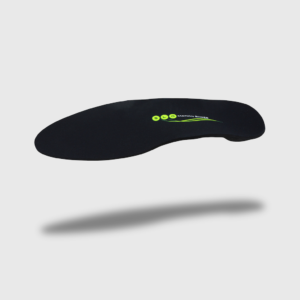The deep peroneal nerve, which runs along the top of the foot, gives sensation to your first and second toes and the area between them. Deep peroneal neuritis refers to pain caused by injury to this nerve. Since the skin and underlying tissue on the top of your foot are very thin, the deep peroneal nerve is susceptible to pressure related injury.

Symptoms
Radiating sharp pain to the top of the foot extending to first and second toes
Severe pain that may be described as “shooting”, “burning”, “numbing”, or “knife-like”
Pain worsens when top part of shoe comes in contact with the nerve
Causes
Pressure from top portion or upper of shoe
Shoes with strap buckle closure or a hard, inflexible upper
High arch or instep
Blow or force to the area resulting in bad bruises or heavy pressure over nerve area
Dislocation and fractured/broken bones in the top of the foot
Twisting or overextending that causes tearing / injury to nerve
Treatment
It is important to consult with a doctor whenever you experience nerve pain in the foot to rule out underlying causes. Nerves that enter the foot can be at greater risk for altered function. Treatment focus is on relieving pressure over the deep peroneal nerve.
Wear a shoe with adequate depth and adjustable lacing system
Choose a shoe that eliminates all pressure on the top of your foot
Wear a shoe that has a padded tongue
Ice area as needed
Using an over-the-counter pain medication, such as ibuprofen (Advil, Motrin) or naproxen (Aleve) may have limited effectiveness
The deep peroneal nerve, a branch of the sciatic nerve complex originates from the spine and courses the top of the foot giving sensation to the first and second toe. The skin and underlying tissue on the top of the foot is very thin and is at risk of pressure related injury. Neuritis refers to inflammation of a nerve. Pressure exerted from the top portion or upper of the shoe can contribute to deep peroneal neuritis. Pain that is neurologic in origin can be quite severe and can be described as shooting, burning, radiating, knife-like or numbing in quality with pressure from the shoe.
Anytime there is a nerve “problem” it is important to make sure that there is no history of sciatica and low back because nerves that enter the foot can be at greater risk for altered function. Symptoms associated with deep peroneal neuritis tend to be relieved with removing the shoe pressure. People with a high arch or instep may have a greater risk of developing deep peroneal neuritis based on the volume of their foot. Shoes with strap buckle closure system or clogs with a closed upper are also suspect.
Treatment is primarily focused on reducing the pressure overlying the nerve. Lacing techniques can “bypass” the painful area on top of the foot to relieve pressure. The tongue of the shoe can also be padded in the form of “railroad tracks” to relieve the pressure of the upper portion of the shoe. A style change including the use of sandals can also help to relieve pressure and the painful symptoms associated with deep peroneal neuritis.
Deep Personal Neurities Discussion Board
Select a View
Click on the view that most represents the area of discomfort that you are experiencing. Drag your cursor over your area of concern to obtain a brief description of the potential condition.
Suggested Product
-

Valgus Orthotic
$75.00Our max support orthotic features postings on the heel and midfoot.Select options







